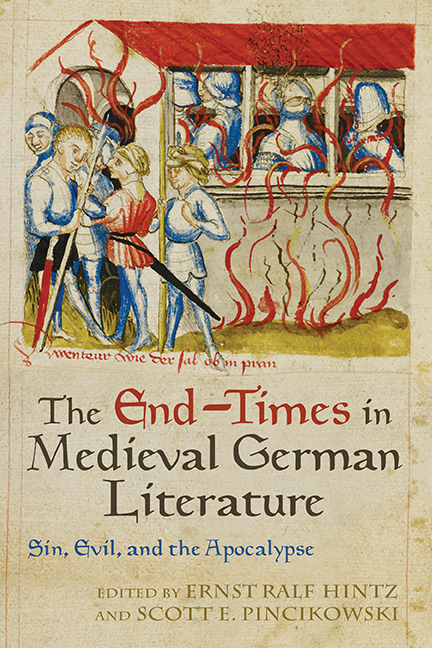Book contents
- Frontmatter
- Dedication
- Contents
- Acknowledgments
- Introduction
- 1 Thiu wirsa giburd: Cain’s Legacy, Original Sin, and the End of the World in the Old Saxon Genesis
- 2 The Heliand Revisited: Spiritual Transgendering and the Defiance of Evil
- 3 The Beginning of the End: Binary Dynamics and Initiative in Hartmann von Aue’s Gregorius
- 4 Poetic Reflections in Medieval German Literature on Tragic Conflicts, Massive Death, and Armageddon
- 5 Beyond Good and Evil: Apocalyptic Vision without Judgment in the Nibelungenlied. An Essay
- 6 End-Times in the Hall: The Modern Reception of the Apocalyptic Ending of the Nibelungenlied
- 7 Past Present, Future Present? Visualizing Arthurian Romance and the Beholder’s Share in a World That Refuses to End
- 8 Ich diene und wirbe / biz ich gar verdirbe: Lovesickness, Apocalypse, and the End-Times in Mauritius von Craûn and Das Nibelungenlied
- 9 The Slippery Concept of Evil in Hartmann von Aue’s Erec and Iwein
- 10 Wigamur’s Lessons on the Complexity of Evil
- 11 The Miracles of the Antichrist
- 12 Monsters and Monstrosities in the Pamphlet Wars of the Reformation
- Notes on the Contributors
- Index
Introduction
Published online by Cambridge University Press: 21 March 2020
- Frontmatter
- Dedication
- Contents
- Acknowledgments
- Introduction
- 1 Thiu wirsa giburd: Cain’s Legacy, Original Sin, and the End of the World in the Old Saxon Genesis
- 2 The Heliand Revisited: Spiritual Transgendering and the Defiance of Evil
- 3 The Beginning of the End: Binary Dynamics and Initiative in Hartmann von Aue’s Gregorius
- 4 Poetic Reflections in Medieval German Literature on Tragic Conflicts, Massive Death, and Armageddon
- 5 Beyond Good and Evil: Apocalyptic Vision without Judgment in the Nibelungenlied. An Essay
- 6 End-Times in the Hall: The Modern Reception of the Apocalyptic Ending of the Nibelungenlied
- 7 Past Present, Future Present? Visualizing Arthurian Romance and the Beholder’s Share in a World That Refuses to End
- 8 Ich diene und wirbe / biz ich gar verdirbe: Lovesickness, Apocalypse, and the End-Times in Mauritius von Craûn and Das Nibelungenlied
- 9 The Slippery Concept of Evil in Hartmann von Aue’s Erec and Iwein
- 10 Wigamur’s Lessons on the Complexity of Evil
- 11 The Miracles of the Antichrist
- 12 Monsters and Monstrosities in the Pamphlet Wars of the Reformation
- Notes on the Contributors
- Index
Summary
THᴇ CONTEMPORARY FᴀSCINᴀᴛIᴏN with the end of the world and life as we know it would have surprised our counterparts a millennium ago only insofar as the end has not yet occurred. In the early twenty-first century, our vision of the apocalypse encompasses climate change, terrorism, antibiotic-resistant bacteria, and war. Popular culture expresses the fear associated with these global crises, obsessively portraying zombies, alien attacks, pandemics, and self-destructive technologies. This book investigates how people in medieval Germany and beyond envisioned their own end-times, their expectations of the apocalypse, the fear of evil, and dread of imminent judgment.
Akin to the fear of nuclear Armageddon in the Cold War decades of the last century, a time when schoolchildren cowered under wooden desks for shelter, the fear of the end of days has permeated and helped shape Western society from the early church well into the early modern era. Even for many circumspect people in our own century, concern over a looming dystopia remains ever pervasive. In Western Christendom, a befitting image of the echatological undercurrent that flowed through centuries deemed “medieval” appears in the New Testament Book of Revelation, known also as the Apocalypse. When the Lamb breaks the first four of seven seals, four horsemen emerge (Rev. 6:1–8). The first rider, on a white horse, carries a bow and embodies the conqueror. The second rides a red horse, bringing conflict to inflict suffering on the world. The third rider, on a black steed and with scales in hand, spreads scarcity in myriad ways, by famine as well as economic uncertainty from war and inflation. In concert with the first three, Death, the fourth horseman, rides a pale horse reminiscent of decay and putrid flesh. All four are bound together and share a mutual causality, expressing an underlying anxiety about the causes of human suffering and death, and the promise of an afterlife in hell for sinners and the potential reward of eternal joy in heaven for the righteous. It can be said with a measure of certainty that the longevity of this eschatological anxiety attests to our human predilection with finality, be it our own finite span or the end of life on earth as we know it.
- Type
- Chapter
- Information
- The End-Times in Medieval German LiteratureSin, Evil, and the Apocalypse, pp. 1 - 6Publisher: Boydell & BrewerPrint publication year: 2019



